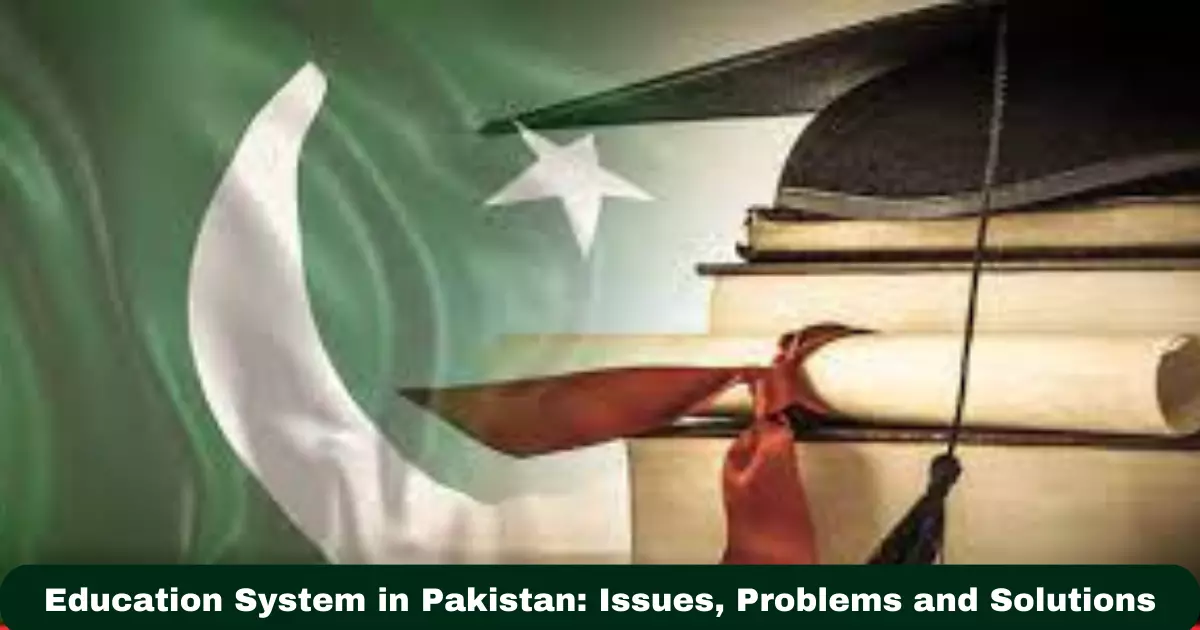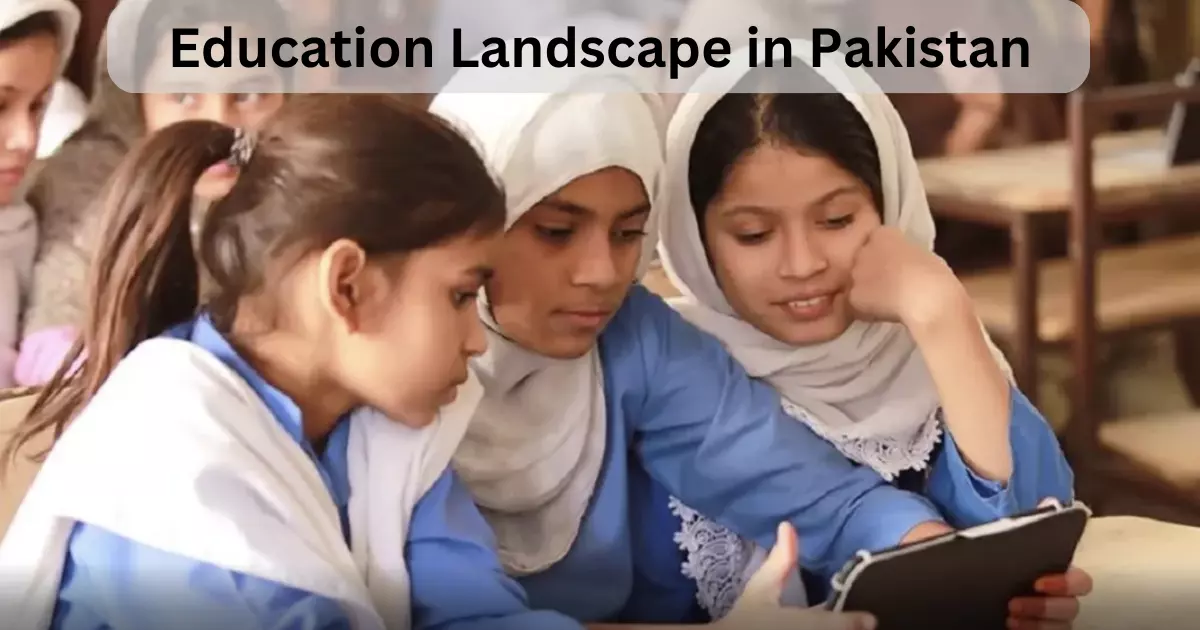Welcome to an exploration of Pakistan’s education system: its challenges, its promises, and the path forward. This article dissects the issues plaguing education, offers solutions, and dives into the diverse landscape of learning in Pakistan.

Join us in uncovering the hurdles, understanding the complexities, and discovering the solutions vital for transforming education in this dynamic nation.”
Issues Impacting Education
Education in Pakistan faces multifaceted challenges, hindering its progress and impeding the fulfillment of crucial global commitments. Understanding these issues is pivotal in devising effective solutions.
Meeting MDGs and Pakistan’s Status:
Pakistan is dedicated to attaining the Millennium Development Goals (MDGs) which encompass achieving education. However, despite making progress the country faces challenges in meeting these objectives. Issues, like poverty, gender inequality, and insufficient infrastructure pose barriers, to accessing quality education in regions and marginalized communities. This discrepancy between commitment and reality highlights a critical issue that needs urgent attention.
Challenges with Education for All Commitment:
The Education for All (EFA) commitment remains a formidable challenge. While strides have been made in increasing enrollment, retention rates, teacher quality, and curriculum relevance remain problematic. Disparities in education persist based on gender, socio-economic status, and geographical location, posing significant hurdles to achieving comprehensive education for all.
Vision 2030 and Education Goals:
Vision 2030 outlines ambitious goals for Pakistan’s development, including educational reforms. However, inadequate policy implementation, insufficient budget allocation, and bureaucratic hurdles hamper progress. Bridging the gap between vision and execution is essential for realizing sustainable advancements in the education sector.
These issues collectively illustrate the systemic challenges embedded in Pakistan’s education system. Tackling these hurdles demands a holistic approach, addressing infrastructure gaps, socio-economic disparities, policy execution, and societal mindsets toward education. The subsequent sections will delve into specific problems within various educational tiers and propose actionable solutions to combat these pressing issues.
Identified Problems
The educational landscape in Pakistan is marred by a spectrum of challenges across different tiers, hindering the holistic development of its populace.
Primary, Middle, and Secondary Education Challenges:
Challenges, in education include facilities, a shortage of qualified teachers, and low enrollment rates, particularly in rural areas. Middle and secondary education encounter difficulties such, as dropout rates, outdated curricula, and limited availability of quality learning materials. These challenges perpetuate an environment where foundational knowledge and skills remain deficient among a significant portion of the population.
Vocational and Tertiary Education Issues:
Vocational education encounters a lack of emphasis and recognition, leading to a dearth of skilled labor. Tertiary education confronts challenges related to limited access to quality institutions, outdated teaching methodologies, and a mismatch between curriculum and industry needs. These factors hinder the country’s ability to produce a competitive, skilled workforce equipped for a rapidly evolving job market.
Issues with Secondary/Higher Secondary Education System:
The secondary and higher secondary education system struggles with disparities in quality between public and private institutions. Moreover, the emphasis on rote learning over critical thinking stifles creativity and innovation among students. Standardized testing and assessment methodologies often fail to evaluate holistic learning, focusing primarily on memorization.
The Role of Community Colleges:
Community colleges intended to bridge the gap between secondary education and higher learning, face challenges in recognition, funding, and curriculum relevance. Lack of awareness and support limits their efficacy in offering diverse educational opportunities beyond traditional pathways.
Addressing these problems necessitates a comprehensive overhaul of educational policies, infrastructure development, teacher training, curriculum redesign, and a shift in societal perspectives towards alternative educational pathways. The subsequent section will outline actionable solutions and recommendations aimed at tackling these entrenched issues to foster a more robust and inclusive educational system in Pakistan.
Read more about: Scope of MBA In Pakistan: Perfect Guide
Solutions and Recommendations
Resolving the intricate issues entrenched within Pakistan’s education system demands a multifaceted approach, combining policy reforms, infrastructure enhancement, and a paradigm shift in educational practices.
Revamping Primary, Middle, and Secondary Education:
- Infrastructure Improvement: Investing in infrastructure upgrades in rural areas, ensuring schools have adequate facilities and are accessible to all communities.
- Teacher Training and Support: Enhancing teacher training programs, incentivizing qualified educators to work in remote areas, and ensuring ongoing professional development.
- Curriculum Enhancement: Updating curricula to be more relevant, inclusive, and aligned with modern pedagogical approaches, focusing on critical thinking and practical skills.
Enhancing Vocational and Tertiary Education:
- Promoting Vocational Training: Elevating the status of vocational education, expanding vocational training centers, and forging industry partnerships for practical skill development.
- Quality Assurance in Tertiary Institutes: Implementing rigorous quality standards in tertiary institutions, updating course content to meet industry demands, and fostering research and innovation.
Strengthening Community Colleges:
- Awareness and Promotion: Raising awareness about the benefits of community colleges, promoting their role in providing alternative educational pathways, and ensuring their accreditation and integration within the broader educational framework.
- Expanding Curriculum Options: Diversifying course offerings in community colleges to cater to a wide array of interests and career paths, incorporating practical, job-oriented skills.
Strategies for Improvement in Higher Education:
- Industry-Academia Collaboration: Promoting collaborations, between institutions and businesses to synchronize the curriculum with the demands of the job market guaranteeing that graduates acquire the necessary skills.
- Research and Innovation: Promoting the development of research infrastructure, cultivating a climate of creativity and ingenuity, and providing incentives for research endeavors to stay on par with progress.
When these solutions are implemented together in a manner they have the potential to bring about a transformation, in the education system of Pakistan. However, it is crucial for the government, educational institutions, civil society, and the private sector to work together diligently and make progress to ensure development in the field of education.
Education Landscape in Pakistan

Understanding the historical context, current allocations, and various stages of formal education elucidates the intricate tapestry of Pakistan’s educational system.
Historical Context of Education:
- Early Educational Systems: Pakistan’s educational journey traces back to ancient civilizations, with an early emphasis on religious education and centers of learning.
- Colonial Influence: British rule introduced a formal education system, primarily serving the elite, leading to a disparity in educational access and quality among different societal strata.
Government’s Budgetary Allocation for Education:
- Budgetary Trends: Analyzing the government’s allocation for education over the years, highlighting any fluctuations, trends, or inadequacies.
- Impact of Budgetary Policies: Understanding the correlation between budgetary allocations, infrastructure development, and educational outcomes.
Different Stages of Formal Education:
- Primary Education: Describing the foundational stage of education, its importance, challenges, and enrollment statistics.
- Secondary Education: Exploring the transition from primary to secondary education, challenges faced, and the impact on future opportunities.
- Tertiary Education: Investigating the landscape of higher education, including universities, colleges, and their contributions to workforce development.
- Quaternary Education: Examining specialized higher education, research institutions, and their role in advancing knowledge and innovation.
- Non-formal and Informal Education: Recognizing alternative learning pathways, their significance in addressing educational disparities, and their integration within the formal system.
- Madrassas: Understanding the role, challenges, and reforms in religious educational institutions.
Analyzing these different facets provides a comprehensive overview of Pakistan’s educational landscape, shedding light on the strengths, weaknesses, and opportunities present within the system. This understanding is crucial for devising targeted interventions and policies aimed at fostering a more inclusive, accessible, and effective education system in the country.
Know more: BBA Scope in Pakistan – Your Ultimate Career Game Changer
Focus Areas for Progress
Within Pakistan’s education system, specific sectors and initiatives require focused attention to drive meaningful progress and ensure comprehensive development.
Degree Awarding Institutions/Universities in Pakistan:
- Quality and Accreditation: Evaluating the caliber of universities and colleges and the criteria, for accreditation. How they influence brilliance and career prospects.
- Research and Innovation: Universities play a role, in driving knowledge and technology showcasing their research output, and fostering innovation hubs.
Technical & Vocational Education and Training (TVET):
- Aligning with Industry Needs: Strengthening TVET programs to meet the demands of evolving industries, ensuring graduates possess practical skills and are job-ready.
- Promoting Vocational Training: Encouraging the perception shift towards vocational education, emphasizing its importance in national development.
Skill Development and Incubation Centers:
- Entrepreneurship and Skill Enhancement: Empowering youth through skill development programs, fostering an entrepreneurial mindset, and establishing incubation centers for startups and innovation.
- Partnerships and Support: Collaborating with private enterprises and government initiatives to support skill development and incubation programs.
Government Policies and Initiatives:
- Policy Analysis: Evaluating existing educational policies, their efficacy, implementation challenges, and potential areas for improvement.
- Initiatives for Access: Highlighting government initiatives aimed at increasing access to education, addressing disparities, and promoting inclusivity.
Market Insights:
- Aligning Education with Market Demands: Understanding market trends, skills in demand, and aligning educational curricula to bridge the gap between academia and industry.
- Employment Opportunities: Exploring job prospects, identifying sectors with growth potential, and preparing students accordingly.
Focusing on these areas presents opportunities for targeted interventions and strategic investments, fostering a more responsive, inclusive, and dynamic educational ecosystem in Pakistan. Collaboration among stakeholders, innovative approaches, and a commitment to addressing these focal points can pave the way for a brighter future for education in the country.
Conclusion
Pakistan’s education system stands at a critical juncture, grappling with myriad challenges while holding immense potential for transformation. From issues in access and quality across different educational tiers to the need for policy reforms, infrastructure enhancements, and a paradigm shift in educational practices, the landscape is complex and multifaceted.
However, within these challenges lie opportunities for progress and innovation. By implementing the outlined solutions, focusing on key sectors, and fostering collaborative efforts among stakeholders, Pakistan can pave the way for a more inclusive, accessible, and effective educational system.
It’s a collective responsibility to invest in education, a fundamental cornerstone for societal growth, economic prosperity, and individual empowerment. The journey toward an improved education system requires sustained dedication, visionary leadership, and a commitment to nurturing the potential of every learner, ensuring a brighter future for generations to come.
FAQs:
Inadequate infrastructure, low budget, outdated curricula, and a shortage of qualified teachers.
Girls face barriers; solutions include gender-sensitive curricula, improved infrastructure for girls’ schools, and changing societal attitudes.
Poverty prevents attendance; solutions include need-based scholarships, increased funding in low-income areas, and free or subsidized textbooks.
Insufficient training affects quality; solutions include ongoing teacher training, updated methodologies, and incentives for professional development.
Outdated curricula hinder relevance; solutions include a comprehensive overhaul, modern teaching methods, and collaboration with industry experts.
Limited access hinders tech use; solutions include digital learning initiatives, infrastructure investment, and training for teachers and students.
